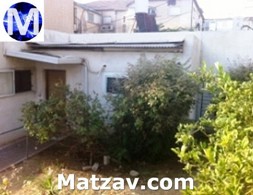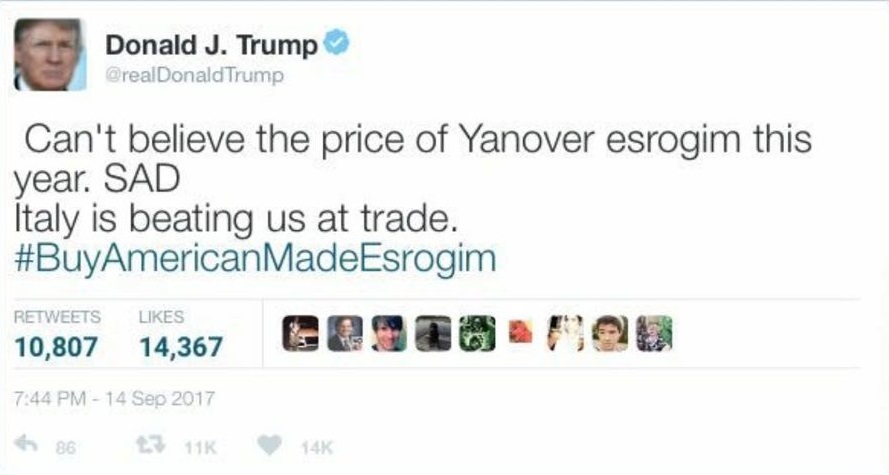from : http://matzav.com/historic-esrog-tree-in-rav-michel-yehudahs-yard-has-died
Thursday September 1, 2011 12:39 PM
 It is well-known that Rav Michel Yehudah Lefkowitz zt”l, rosh yeshiva of Yeshivas Ponovezh L’tzeirim, who was niftar this summer, was given seeds of an esrog by the Chazon Ish to plant to produce esrogim that are pure and are under no suspicion of being murkav, grafted. The Chazon Ish had approached him with an esrog that he said was definitely kosher and was not grafted. The Chazon Ish actually asked Rav Michel Yehudah to plant the esrog seeds in his yard and told him that he would have parnassah from it.
It is well-known that Rav Michel Yehudah Lefkowitz zt”l, rosh yeshiva of Yeshivas Ponovezh L’tzeirim, who was niftar this summer, was given seeds of an esrog by the Chazon Ish to plant to produce esrogim that are pure and are under no suspicion of being murkav, grafted. The Chazon Ish had approached him with an esrog that he said was definitely kosher and was not grafted. The Chazon Ish actually asked Rav Michel Yehudah to plant the esrog seeds in his yard and told him that he would have parnassah from it.
Rav Michel Yehudah asked, “Can an esrog grow in the Bnei Brak climate? Moreover, I don’t have any experience growing esrogim, and an esrog tree takes much time to cultivate. I don’t have time to cultivate it; I want to learn Torah!”
The Chazon Ish replied that all he would have to do was plant the esrog and water it. The Chazon Ish promised him that it would not take up much of his time.
 The esrog tree in Rav Michel Yehudah’s yard.
The esrog tree in Rav Michel Yehudah’s yard.
Remarkably, that esrog tree grew into the famous “Lefkowitz-Chazon Ish Esrogim.” Rav Michel Yehudah barely had to invest any time into it, despite the fact that an esrog tree is usually very sensitive, requires much attention, and does not last for many years. 70 years later, that tree stood tall in Rav Michel Yehudah’s yard and was still producing beautiful esrogim.
However, this month, news emerged from Bnei Brak that the historic tree has died. Since the time of Rav Michel Yehudah’s petirah, the tree’s branches have gradually been getting dried out, and, at the present time, the tree is all but dead. The fruit have fallen off and the branches have dried out.
Upon learning of the news, the Toldos Aharon Rebbe, who is makpid each Sukkos to make a bracha on an esrog from Rav Michel Yehudah’s yard, sent chassidim to confirm the report. They indeed found that the tree has withered.
While the general story of the Chazon Ish’s esrog tree is well-known, there are some lesser known facts and stories about the tree:
Rav Michel Yehudah said that when he asked the Chazon Ish what din the esrog had, the Chazon Ish responded that “it has a din of masores” [tradition, just as if the subject esrog had been handed down from generation to generation].
The Chazon Ish constantly inquired after the welfare of the tree, asking Rav Michel Yehudah if he was watering it enough, etc. His grandson related that during the second year of the tree’s life, it looked like it would fail. Rav Michel Yehudah reported this to the Chazon Ish and the Chazon Ish told him not to worry. “If the Ribbono Shel Olam desires it,” said the Chazon Ish, “He can make a wind come that will revive the tree [and make it live for many years].” There was an immediate improvement and, as is well known, the tree lived more than 60 years after its planting, despite generally short life spans for esrog trees.
The first year after the fourth year of the tree’s production [the tree’s produce is forbidden until after the fourth year], the Chazon Ish went to Rav Michel Yehudah’s home to personally choose his esrog, getting down on his hands and knees under the tree’s branches to select the best esrog.
The Steipler Gaon did this all his life, selecting his esrog (and one for his daughter, Rebbetzin Barzam) on the 15th of Av. The Steipler would inquire throughout the year as to the status of tree. Interestingly, during the last year of his life, he did not inquire as to the status of the tree; the Steipler ultimately passed away on the 23rd of Av and was too ill that year to have chosen his esrog on the 15th of Av.
When the Steipler would come to select his esrog from Rav Michel Yehudah, he would give Rav Michel Yehudah an amount of money. Inevitably, Rav Michel Yehudah would protest that it was too much, to which the Steipler would reply, “You’re giving me everything. I’m giving you nothing.”
Until this year, each Sukkos, Rav Chaim Kanievsky made his bracha only over an esrog from this tree, regardless of whether another esrog might be cleaner.
As is well-known, Rav Michel Yehudah gave anyone the right to cultivate the seeds and start an orchard from his tree, with no request for compensation.
And now, with the tree having died, those who are makpid to obtain “Lefkowitz esrogim” will have to look for a tree planted with seeds from the original tree.
{Yair Alpert-Matzav.com Israel}


 It is well-known that Rav Michel Yehudah Lefkowitz zt”l, rosh yeshiva of Yeshivas Ponovezh L’tzeirim, who was niftar this summer, was given seeds of an esrog by the Chazon Ish to plant to produce esrogim that are pure and are under no suspicion of being murkav, grafted. The Chazon Ish had approached him with an esrog that he said was definitely kosher and was not grafted. The Chazon Ish actually asked Rav Michel Yehudah to plant the esrog seeds in his yard and told him that he would have parnassah from it.
It is well-known that Rav Michel Yehudah Lefkowitz zt”l, rosh yeshiva of Yeshivas Ponovezh L’tzeirim, who was niftar this summer, was given seeds of an esrog by the Chazon Ish to plant to produce esrogim that are pure and are under no suspicion of being murkav, grafted. The Chazon Ish had approached him with an esrog that he said was definitely kosher and was not grafted. The Chazon Ish actually asked Rav Michel Yehudah to plant the esrog seeds in his yard and told him that he would have parnassah from it. The esrog tree in Rav Michel Yehudah’s yard.
The esrog tree in Rav Michel Yehudah’s yard.